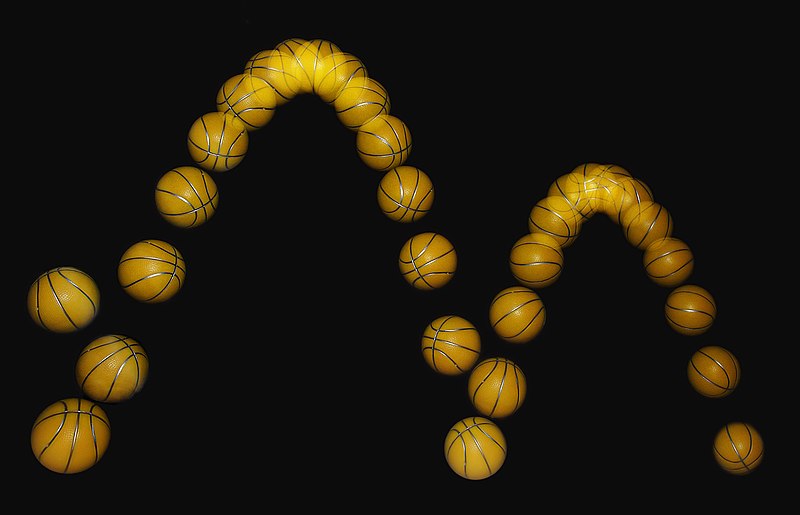.
A bouncing ball captured with a stroboscopic flash at 25 images per
second. Note that the ball becomes significantly non-spherical after
each bounce, especially after the first. That, along with spin and
air-resistance, causes the curve swept out to deviate slightly from the
expected perfect parabola. Spin also causes the angle of first bounce to
be shallower than expected. As a ball falls freely under the influence
of gravity, it accelerates downward, its initial potential energy
converting into kinetic energy. On impact with a hard surface the ball
deforms, converting the kinetic energy into elastic potential energy. As
the ball springs back, the energy converts back firstly to kinetic
energy and then as the ball re-gains height into potential energy.
Energy losses due to inelastic deformation and air resistance cause each
successive bounce to be lower than the last. The image is of a child's ball about the size of a tennis ball: image by Michael Maggs, 29 September 2007; edit by Richard Bartz
You approach me carrying a book
The instructions you read carry me back beyond birth
To childhood and a courtyard bouncing a ball
The town is silent there is only one recreation
It’s throwing the ball against the wall and waiting
To see if it returns
One day
The wall reverses
The ball bounces the other way
Across this barrier into the future
Where it begets occupations names
This is known as the human heart a muscle
A woman adopts it it enters her chest
She falls from a train
The woman rebounds 500 miles back to her childhood
The heart falls from her clothing you retrieve it
Turn it over in your hand the trademark
Gives the name of a noted maker of balls
Elastic flexible yes but this is awful
You say
Her body is limp not plastic
Your heart is missing from it
You replace your heart in your breast and go on your way

The concrete map of unknown places: image by di de, 22 January 2006

The ball that I threw when I played in the park not yet has touched the ground...
ReplyDeleteDylan Thomas
—
Sandra, You have reminded me that this poem is about resiliency. A good thing, evidently.
ReplyDeleteBut can there be too much of a good thing?
interesting....it all depends...:)
ReplyDeleteTalking about floored by beauty.... oh my. It is going to be hard to get up from down there. Balls desperatly thrown at open chests. The waiting and hope for a bounce, but the hollow chest is in need of a heart and it swalled the ball in a merciless grasp, keeping it for himself.
ReplyDeleteWhat kind of wall am I? Brick? Wood? Rubber? Paper? Would anything bounce back? Pass through? Get stuck?
Ah, those lines are just too beautiful to add anything at all, Tom. Yes, there can be too much of a good thing.
Beautiful lines that bounce me back to
ReplyDeletemy first encounter with resiliency.
I did that as a child - outside the block of flats we lived in & down the road where there was a fragment of wall left over from a 1940s bomb (there were still such fragments in the 1960s into the 1970s). Bouncing a ball, catching it, bouncing it off the ground onto the wall or directly at the wall. Resiliency, but also reciprocity of a kind. The wall is a wall, but it also stands (in) for ... the other? The world? Its mute materiality allows for an imaginative space but is also emblematically frustrating, baffling. It's only a wall.
ReplyDelete"To childhood and a courtyard bouncing a ball" gives me a sense of the courtyard's agency, rather than the bouncer of a ball's.
Isn't that video just glorious? 250.000 balls, that's 250.000 balls to pick up, someone said in the comments. Some of them might still be around! And how on earth did they get that frog jumping out of the gutter in the middle of all these colours? Just great....
ReplyDeleteBouncing ball; heart as sign; muscle; the woman; the ball again: how the figure flickers through one form, one time and place to the next. That last line is a relief from those intense exhilarating shifts. We go on our way to the ordinary again.
ReplyDeleteAppreciate the comments from everyone!
ReplyDeleteI've said the poem was about resiliency. Well, it is indeed that, in regard to what it suggests about the emotional makeup of human beings It is also about hyperelasticity, in regard to what it suggests about the physical makeup of vulcanized polymers and of biological connective tissue.
Like many lads before (though perhaps fewer after, what with changing times and all), the person who wrote the poem -- some 48 years ago this month, as it happens -- had spent thousands of innocuous boyhood hours bouncing rubber balls against walls (among other surfaces).
At the time the poem was writ, a new recreational product had lately been introduced: the Super Ball, invented by Norman Stingley, and marketed by the Wham-O Toy Company (which had already brought into the world those invaluable cultural improvements the Hula Hoop and the Frisbee).
This new toy consisted of an extremely elastic ball made of the Krypton-like material called Zectron, containing the synthetic polymer polybutadiene as well as hydrated silica, zinc oxide, stearic acid, and other ingredients. This compound was vulcanized with sulfur at a temperature of 165 degrees Celsius and formed at a pressure of 3,500psi. The resulting ball possessed an amazingly high coefficient of restitution. Dropped from shoulder level, the Super Ball would snap nearly all the way back; thrown down by an average adult, it could bound like Superman over a three-story building.
The Super Ball quickly became a fad. Lamar Hunt, owner of the pointy-end-footballing Dallas Cowkiller Boys, picked up on the name -- and thus was born, yes, the Super Bowl.
The Super Ball is the venerable ancestor of the modern Bouncy Ball, which consists of the same basic product under a different name, and has now become a hyperelastic footsoldier in Sony's global marketing army.
The poem was "performed", somewhat painfully, at one of those grand jamboree poetry events of yesteryear. This occurred at the Albert Hall in London, in the spring of 1965. The performer was decked out in an overlarge black leather coat purchased for five quid on the King's Road two weeks before. At this point the poem bore the title "Superballs". When the title was announced, it became immediately apparent that poems read in giant halls with multiple balconies ought to have less challenging titles. Some invisible wag buried deep in the dark reaches of an upper balcony (how many holes would it take to fill the Albert Hall) hollered out, in a lovely Cockney accent, "Wot?" The title was dutifully reiterated. And then, that challenging "Wot? again. And the title a third time. Once more the echoing bellow, across the widening chasm, "Wot?"
(Poetry and "performance" -- a matter less of kissing cousins than of spatting in-laws, on so many occasions).
Hyperelasticity, a theme, then.
ReplyDeleteCoincidentally (or not), the person who wrote the poem had been diagnosed, after experiencing many unusual childhood ailments and injuries, with a genetic condition named after the two European doctors, one Danish, one French, who had identified it at the beginning of the twentieth century. Ehlers-Danlos syndrome: an inherited connective-tissue disorder caused by a defect in the synthesis of collagen -- the ingredient in connective tissue which enables the tissue to resist deformation. Collagen is an essential contributor to the physical strength of skin, joints, muscles, ligaments, blood vessels and visceral organs. Abnormal collagen renders these structures more elastic.
The diagnosis was made by a canny old physician who had observed the condition before (relatively few doctors have seen it clinically, the vast majority know of it, if at all, only from books). To one's concerned mother he said: "This young man should be treated as though he were a fine piece of Dresden china. He should avoid stress throughout his life."
If only... but still, the "fine" was a nice touch, one does recall having thought gratefully at the time.
The physical effects of the condition include various funhouse oddities and abnormalities as well as some that have turned out, over time, to be not-so-fun... and have indeed been getting less fun (not to accord undue importance to fun of course, but still) with every passing minute, given life's way of providing routine and not-so-routine stresses (being hit by a speeding auto at an advanced age, for example -- surviving and recovering from that sort of event is complicated more than a bit by EDS).
Like so many things, all this can be seen to have a humorous aspect -- when young.
There is for example a pleasant-seeming bloke named Gary Turner who's become mildly famous as the so-called élastique man!!!.
But the line between amusement and agony, celebrity and freak, can easily blur.
Well, while we're on confessions, perhaps it's also time to admit it did feel a trifle awkward to be reducing oneself to a micro-pimp for Sony Bravia TVs. But when in Rome... or near San Francisco... where is proper shame anymore?
ReplyDeleteAs you may have guessed, that advert took a massive production crew and cost more money to produce than many a feature film. Well, the bouncy stars donated their services gratis, so that cut into the expenses a bit. Still, for them, the work was literally downhill all the way. And about that frog -- one assumes it was non-union, and hopes it received at least free lunch. (A delicious-looking brightly-coloured hyperelastic rubber insect, maybe??)
There are variant versions of the advert. This one extends into a behind-the-scenes documentary revealing the mechanics of the operation. In other versions of the making-of we get the global marketing mantra loud and clear.
"It's all about connecting people emotionally..."
(Whenever you hear any of the various forms of the verb "to connect", these days, especially when used by a corporate "host" -- e.g., "the new Facebook Home" -- you can be certain whoever's saying it is also thinking "to collect" -- your money, your data, in fact, basically, whatever you've got.)
Sony Bravia Bouncy Balls (& the Making Of...)
The Sony ad quickly spawned further marketing clones of itself. An advertising campaign for 'Tango Clear", a soft drink sold in the UK, Ireland and some countries in Europe, was launched, parodying the Sony Bouncy Balls advert. A remarkably close copy, though filmed not in San Francisco but in Swansea (!), using not hyperelastic balls but a great load of (totally wasted) fruit, and including, even, the frog ejected from the drainpipe. But the Tango frog appears dazed, bruised, bothered and bewildered by the extremely traumatic ejection and bombardment. Really, one longed to see a disclaimer, "No animals were hurt in the filming of this advert...". But no. Amphibian sacrifice, evidently no great matter to the Tango marketing gods.
Tom,
ReplyDeleteHaving thrown lots of balls against walls myself, and also to others down the street or out in the field who would throw or hit them back, I find myself still doing all that these days, playing catch with Johnny, pitching balls to Johnny, watching him it them across the infield or on the fly out to the green world. Keep your eye on the ball.
4.27
light coming into fog against invisible
top of ridge, quails calling from field
in foreground, sound of wave in channel
conscious of actual gesture,
taking up a situation
in the same way, one can be
real, filled with air
white circle of sun in fog above ridge,
cormorant flapping across toward point
Steve,
ReplyDelete"...playing catch with Johnny, pitching balls to Johnny, watching him hit them across the infield or on the fly out to the green world..."
Ah, golden days!
Joseph Ceravolo: Beginner Method
That Tango Clear bouncy-fruit knockoff advert
ReplyDelete